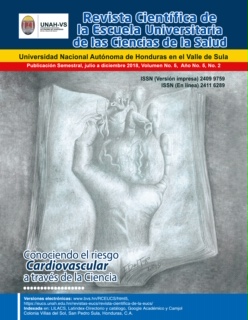CHARACTERIZATION OF HYPERTRIGLYCERIDEMIA AND ANTHROPOMETRY IN ADULTS PATIENTS IN A RURAL COMMUNITY
DOI:
https://doi.org/10.5377/rceucs.v5i2.7633Keywords:
Anthropometry, Sedentary Lifestyle, Hypertriglyceridemia, ObesityAbstract
The report on non communicable diseases of the who in 2010 reports that 80% of deaths are due to noncomunicable disease, among these are the metabolic diseases that affect more middle and lower income populations, different from what is previously belived, wich could be reduce if the popula- tion shows that their habit influence their health. Objective: To characterize the risk factors associated with hypertriglyceridemia levels in 28-40 years patients in the medical center of Ceguaca municipality of Santa Barbara, from September 2016 to February 2017. Patients and Research Methodology: this is a quantitative, descriptive, non-experimental study non probabilistic sample of 50 patients who met the inclusion criteria, with prior informed consent SPSS 23 was used to tabulate and microsoft excell 2016 to graph. Statistical analysis was performed by applying measures of frequency, and percentage for the variables. Result: Of the 50 patients in their majority, women 84% (42), and males 16% (8), the ages of the study popula- tion: between 37-40 years 40% (20), de 28-32 years 34% (17) y de 33-36 years 26% (13). Triglycerides level: in men> 150 mg / dl 100% (8), in Women:> 150 mg / dl 64.3% (27), BMI between 30-39.9: 50% (25), abdominal perimeter: Men> 102 cm 50% (4), women > 88 cm 86% (36), physical activity: 68% had a sedentary lifestyle and also 68% had a family history of dyslipidemia. Conclusion: Our study shows that the majority of young adults presented hypertriglyceridemia; as determining factors the quality of the diet and the lack of realization of physical determinant factors associated to it included. activity, and also the hereditary factor.
Downloads
1071




